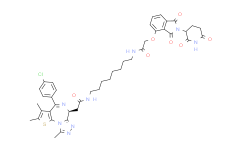| DC60510 |
Iso-A11B5C1
|
Iso-A11B5C1 is an ionizable lipid. The iso-A11B5C1 LNP demonstrates a high level of muscle-specific mRNA delivery efficiency. exhibiting transfection efficiency comparable to the commercially available lipid SM-102, while considerably reducing inadvertent mRNA expression in main organs such as the liver and spleen.Additionally, study results show that intramuscular administration of mRNA formulated with iso-A11B5C1 LNP caused potent cellular immune responses, even with limited expression observed in lymph nodes. |
| DC65680 |
Lipid 2-10
|
Lipid 2-10, an ionizable lipid with a pKa of 6.16, is utilized in the formulation of lipid nanoparticles (LNPs) featuring a bilayer structure. |
| DC60447 |
ARV-766
|
ARV-766 is an orally active and potent proteolysis targeting chimera (PROTAC) protein degrader. ARV-766 degrades wild-type androgen receptor (AR) but also relevant AR LBD mutants, including the most prevalent AR L702H, H875Y, and T878A mutations[1]. |
| DC55003 |
XY028-140 (MS140)
|
XY028-140 (MS-140) is a potent and selective PROTAC-based CDK4/CDK6 kinase degrader. XY028-140 specifically inhibits RB-E2F signaling and reduces CDK4 and CDK6 protein levels in a dose- and time-dependent manner in vitro. In addition, XY028-140 can degrade its targets by linking them with ubiquitin-proteasome mechanism. Further, the degradation of CDK4/6 protein by XY028-140 is specifically mediated by CRBN. Therefore, XY028-140 effectively and selectively inhibits and degrades CDK4/6 kinase by targeting CDK4/6 kinase in CDK4/6i-S (CDK4/6 inhibitor-sensitive) tumor cells to the CRL4-CRBN-E3 ubiquitin complex. Compared with CDK6 wild-type cells, XY028-140 treatment of cells expressing wild-type or mutation-activated CDK6 resulted in a more effective degradation of CDK6 (S178P). |
| DC53120 |
XD2-149
|
XD2-149 is a napabucasin PROTAC as an effective degrader of the E3 ligase ZFP91 with IC50 of 1 μM and 0.8 μM in pancreatic cancer cell lines, MIA PaCa-2 and BxPC-3, respectively. XD2-149 also reduces the expression of STAT3, pSTAT3, and NQO1 proteins. |
| DC51010 |
CID 138454799
|
ERD-308 is a highly potent PROTAC degrader of estrogen receptor (ER) for ER positive breast cancer treatment. |
| DC31014 |
GMB-475
|
GMB-475 is a degrader of BCR-ABL1 tyrosine kinase based on PROTAC, overcoming BCR-ABL1-dependent drug resistance. GMB-475 targets BCR-ABL1 protein and recruits the E3 ligase Von Hippel Lindau (VHL), resulting in ubiquitination and subsequent degradation of the oncogenic fusion protein[1]. |
| DC28018 |
MD-224
|
MD-224 is a first-in-class and highly potent small-molecule human murine double minute 2 (MDM2) degrader based on the proteolysistargeting chimera (PROTAC) concept. MD-224 induces rapid degradation of MDM2 at concentrations <1 nM in human leukemia cells, and achieves an IC50 value of 1.5 nM in inhibition of growth of RS4;11 cells. MD-224 has the potential to be a new class of anticancer agent. |
| DC44401 |
DSPE-PEG14-COOH
|
DSPE-PEG14-COOH is a PEG-based PROTAC linker that can be used in the synthesis of PROTACs. |
| DC44304 |
DSPE-PEG2-mal
|
DSPE-PEG2-mal is a PEG-based PROTAC linker that can be used in the synthesis of PROTACs. |






















